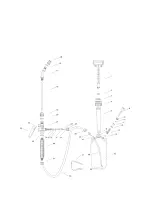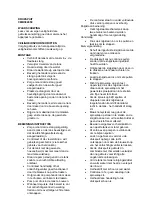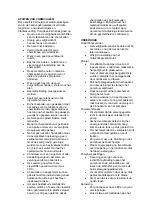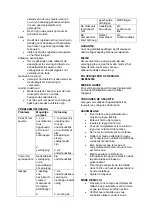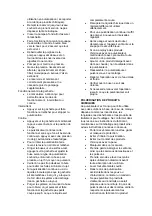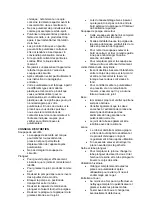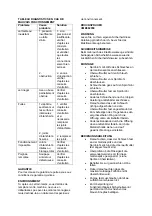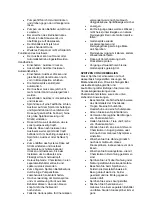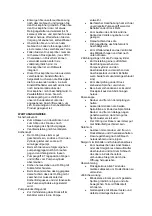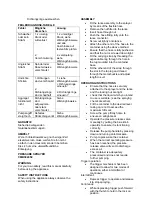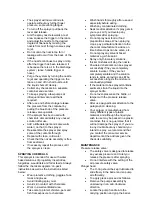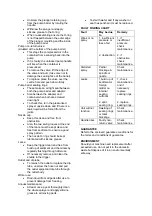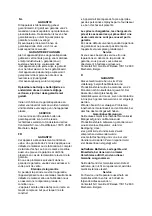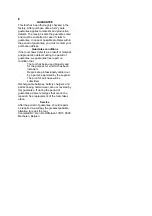
•
The sprayer will now continue to
operate without any further finger
pressure, so preventing fatigue.
•
To turn off the sprayer pull back the
lever and release.
•
Aim the spray nozzle towards a test
area, squeeze the trigger on the lance
and adjust the nozzle to the desired
degree of fineness by twisting the
nozzle from mist through coarse spray
to jet.
•
Do not undo the nozzle too far or
leakage will occur from the back of the
nozzle.
•
If the nozzle continues to spray or drip
after the trigger has been released, it
is because there is air in the discharge
system ( lance, handle trigger or
hose).
•
Purge the system by turning the nozzle
to jet and operating the trigger on the
lance on and off in short bursts until
the liquid shuts off cleanly.
•
Collect any chemicals in a separate
container and use later.
•
To keep spraying a few pumps at
infrequent interval are all that is
required.
•
After use and before storage release
the pressure from the container by
pulling the blue knob of the pressure
release valve upwards.
•
If the sprayer has been used with
chemicals, discard safely any unused
solution after use.
•
Add a little detergent and some warm
water ( not hot) to the sprayer.
•
Re-assemble the sprayer and spray
some of the contents through.
•
Repeat with clean, cold water.
•
Check that the nozzle assembly is free
from sediment.
•
If necessary repeat the process until
the sprayer is clean.
SPRAYING CHEMICALS
This sprayer is intended for use with water
based solutions of proprietary insecticides,
fungicides, weedkillers and follar feeds. Always
follow the chemical suppliers’ on-pack
instructions as well as the instructions listed
below:
•
Wear protective clothing, goggles, face
mask and gloves.
•
Avoid inhaling spray mist.
•
Avoid skin contact with chemicals.
•
Work in a well ventilated area.
•
Take care to protect children, pets and
fish from exposure to chemicals.
•
Wash hands thoroughly after use and
especially before eating.
•
Wash any contaminated clothing.
•
Seek medical attention if spray gets in
your eyes or if you develop any
symptoms after spraying.
•
Do not spray near food or food
preparations areas. When spraying
crops, pay particular attention to the
chemical manufacturer’s advice on
time before crops can be eaten, etc.
•
Do not spray any solvent based
material e.g. white spirit.
•
Spray only thin watery solutions,
thicker mixtures will clog the nozzle.
•
Powdered chemicals can be sprayed
successfully if they are completely
soluble in water. If they are not
completely soluble and the solution
tends to settle, spraying can still be
successful so long as the mixture is
continually agitated.
•
If the material to be sprayed contains
sediment, strain the liquid into the
sprayer bottle.
•
Do not over-pressurise the bottle, or
tamper with the pressure release
valve.
•
After use pay particular attention to the
paragraph on cleaning.
•
Your sprayer is manufactured from
many different types of plastic
material, and although the liquid you
wish to use may be packed in a plastic
container, this is no guarantee that it
will not damage the sprayer. If you are
in any doubt about any chemical you
intend to spray, we recommend that
you contact the consumer service
department at the address given the
check its suitability.
MAINTENANCE
Pressure release valve:
•
The safety valve is designed to release
any excess pressure and to let you
release the pressure after spraying.
•
Do not interfere with the setting of the
air pressure safety valve.
Plunger head:
•
The O-ring should be kept lubricated to
slide freely in the barrel and so pump
air efficiently.
•
To apply grease proceed as follows.
•
Remove the pumps assembly by
unscrewing in an anti-clockwise
direction.
•
Locate the pump handle into the
carrying position and grip the barrel.


